Related Research Articles

A conductor or guard is a train crew member responsible for operational and safety duties that do not involve actual operation of the train/locomotive. The conductor title is most common in North American railway operations, but the role is common worldwide under various job titles. In Commonwealth English, a conductor is also known as guard or train manager.
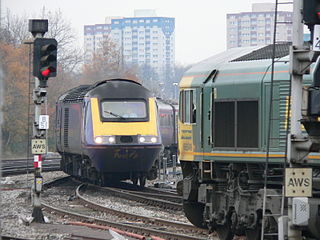
Railway signalling (BE), also called railroad signaling (AE), is a system used to control the movement of railway traffic. Trains move on fixed rails, making them uniquely susceptible to collision. This susceptibility is exacerbated by the enormous weight and inertia of a train, which makes it difficult to quickly stop when encountering an obstacle. In the UK, the Regulation of Railways Act 1889 introduced a series of requirements on matters such as the implementation of interlocked block signalling and other safety measures as a direct result of the Armagh rail disaster in that year.

Diver communications are the methods used by divers to communicate with each other or with surface members of the dive team. In professional diving, diver communication is usually between a single working diver and the diving supervisor at the surface control point. This is considered important both for managing the diving work, and as a safety measure for monitoring the condition of the diver. The traditional method of communication was by line signals, but this has been superseded by voice communication, and line signals are now used in emergencies when voice communications have failed. Surface supplied divers often carry a closed circuit video camera on the helmet which allows the surface team to see what the diver is doing and to be involved in inspection tasks. This can also be used to transmit hand signals to the surface if voice communications fails. Underwater slates may be used to write text messages which can be shown to other divers, and there are some dive computers which allow a limited number of pre-programmed text messages to be sent through-water to other divers or surface personnel with compatible equipment.

On trains, the expression emergency brake has several meanings:
A buzzer or beeper is an audio signaling device, which may be mechanical, electromechanical, or piezoelectric. Typical uses of buzzers and beepers include alarm devices, timers, train and confirmation of user input such as a mouse click or keystroke.
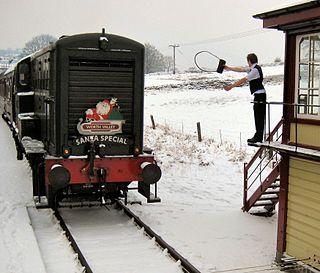
In railway signalling, a token is a physical object which a train driver is required to have or see before entering onto a particular section of single track. The token is clearly endorsed with the names of the section to which it belongs. A token system is more commonly used for single lines because of the greater risk of collision in the event of a mistake being made by a signaller or traincrew, than on double lines.
The signalling system used on the rail transport in Norway is regulated by the Regulations of December 4, 2001 no. 1336 about signals and signs on the state's railway network and connected private tracks.

A signal passed at danger (SPAD), known in the United States as a stop signal overrun and in Canada as passing a stop signal, is an event on a railway where a train passes a stop signal without authority. In the United States and Canada, this may be known colloquially as running a red, though this idiom principally refers to automobiles passing red traffic signals.
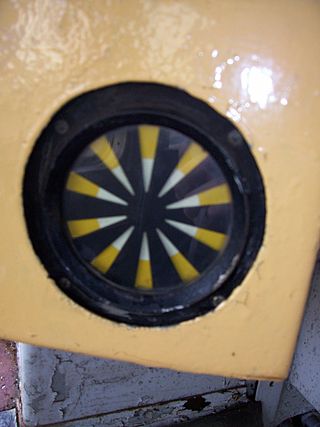
The Automatic Warning System (AWS) provides a train driver with an audible indication of whether the next signal they are approaching is clear or at caution. Depending on the upcoming signal state, the AWS will either produce a 'horn' sound, or a 'bell' sound. If the train driver fails to acknowledge a warning indication, an emergency brake application is initiated by the AWS. However if the driver correctly acknowledges the warning indication by pressing an acknowledgement button, then a visual 'sunflower' is displayed to the driver, as a reminder of the warning.

Cab signaling is a railway safety system that communicates track status and condition information to the cab, crew compartment or driver's compartment of a locomotive, railcar or multiple unit. The information is continually updated giving an easy to read display to the train driver or engine driver.
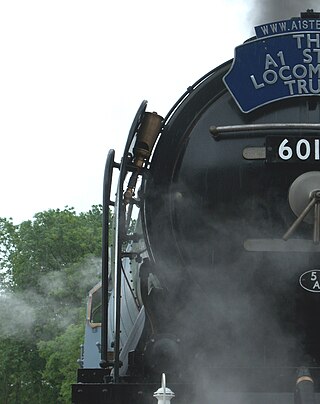
A train whistle or air whistle is an audible signaling device on a steam locomotive, used to warn that the train is approaching, and to communicate with rail workers. Modern diesel and electric locomotives primarily use a powerful air horn instead of a whistle as an audible warning device. However, the word whistle continues to be used by railroaders in referring to such signaling practices as "whistling off".
The railway block signalling bell code is a system of bell sounds used in Great Britain to communicate between manually operated Signal Boxes in implementing the railway block system. Each such signal box has a bell circuit to the boxes on either side of it along the line. The equipment consists of a plunger or tapper which when pressed, rings a single-stroke bell in a neighbouring box. That box similarly has a tapper for communicating back, so boxes have keys each of which rings the bell in a neighbouring box. The bells sound different tones, so that the signalman can tell them apart by ear.

Absolute block signalling is a British signalling block system designed to ensure the safe operation of a railway by allowing only one train to occupy a defined section of track (block) at a time. Each block section is manually controlled by a signalman, who communicates with the other block sections via telegraph. This system was used on double or multiple lines where use of each line is assigned a direction of travel before the introduction of track circuits, and is still used on lines which lack track circuiting.

Transmission Voie-Machine is a form of in-cab signalling originally deployed in France and is mainly used on high-speed railway lines. TVM-300 was the first version, followed by TVM-430.
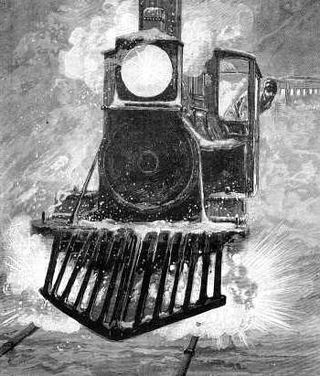
A railway detonator is a coin-sized device that is used as a loud warning signal to train drivers. It is placed on the top of the rail, usually secured with two lead straps, one on each side. When the wheel of the train passes over, it explodes, emitting a loud bang. It was invented in 1841 by English inventor Edward Alfred Cowper.
Ding-ding, and away is a slang expression used by the UK media and railway enthusiasts to describe a type of operating incident in the British railway industry where the guard of a train standing at a platform gives a "ready to start" bell code to the driver, when the platform starting signal is at danger, and the driver then moves the train past the signal without checking it. This constitutes a signal passed at danger (SPAD).
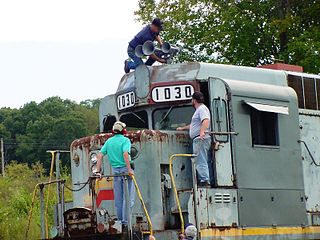
A train horn is an air horn used as an audible warning device on diesel and electric-powered trains. Its primary purpose is to alert persons and animals to an oncoming train, especially when approaching a level crossing. They are often extremely loud, allowing them to be heard from great distances. They are also used for acknowledging signals given by railroad employees, such as during switching operations. For steam locomotives, the equivalent device is a train whistle.
Tyer's Electric Train Tablet system is a form of railway signalling for single line railways used in several countries; it was first devised in Great Britain by engineer Edward Tyer after the Thorpe rail accident of 1874, which left 21 people dead. It was used in New Zealand for close to 100 years until June 1994. The system used a hard disk called a tablet, a form of token.

Cab Secure Radio (CSR) was an in-cab analogue radiotelephone system formerly used on parts of the British railway network. Its main function was to provide a secure speech link between the train driver and the signaller which could not be overheard by other train drivers. In areas where CSR was used, it had to be the primary method of communication between driver and signaller, always being used in preference to the signal post telephone. CSR was replaced by the GSM-R digital system, forming the initial phase of rollout of ERTMS throughout the UK.
The Welwyn Tunnel rail crash took place in Welwyn North Tunnel, north of Welwyn station on the Great Northern Railway, on 9 June 1866. According to L T C Rolt, "from the point of view of damage to engines and rolling stock it was one of the most destructive in railway history."
References
- ↑ "Preparation and movement of trains on ERTMS lines" (PDF). Rail Safety and Standards Board. p. 24. Archived from the original (PDF) on 31 December 2013. Retrieved 28 December 2013.
- ↑ "Chapter IV F. Duties of Staff Working Trains during Journey" (PDF). Indian Railways General Rules. South Eastern Railway. 2011. 4.51. Bell signals between Driver and Guard. Retrieved 7 February 2023.
- ↑ "Communicating Signal Appliance" (PDF). Northeast Operating Rules Advisory Committee. 2008. p. 29. Archived from the original (PDF) on 23 July 2011. Retrieved 9 April 2011.